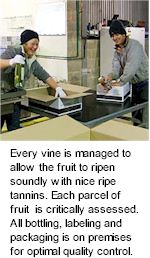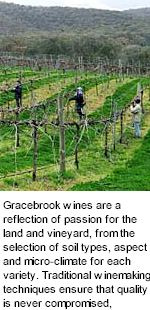


David and Rhonda acquired very early in life the horticultural skills that would later become invaluable when applied to the vineyards of Gracebrook. Both being from farming backgrounds, Rhonda's parents owned and operated a dairy farm here in the King Valley, across the road from what is now their home farm. During Rhonda's holidays and weekends she would work in the local vineyards, either handpicking fruit or pruning vines. David's parents also owned and ran dairy farms as well as growing beef cattle, pigs and later on growing tobacco on a small farm located at Edi. This is when David left school and started farming with his parents.

Gracebrook Vineyard stands in front of the cellar door on an overlay of volcanic red basalt soils, terra rossa. There are some 12 acres (5ha) of vines divided into two separate irrigation blocks to cater for the varying depth of the basalt soil. The original site had a long history of being one of the premium farms of the King Valley. The narrow gauge goods trains that ran from Whitfield to Wangaratta from 1899 until 1952, stopped regularly at the Jarrott siding to collect the produce.
The founding Jarrott family placed the farm on the market in late 1997. This David Maples saw as a tremendous opportunity and exciting challenge. During the next two years, some 75 acres of vineyards were planted on the property along with all supporting infrastructure, from rebuilding and enlarging dams for both stock and irrigation water to fencing and road and track improvements on the property. Years were spent building stockyards and upgrading pasture in the grazing paddocks.
The Gracebrook Stables have been at the heart of the property since the 1880s. Built from local stringybark, red and yellow box round timbers, using traditional bush carpentry methods of the period in its construction. Although in good condition when acquired by the Maples, having withstood the test of time, the stables presented many challenges to David and Rhonda who took on the duty of restoring it back to its former glory.

There is no doubt that the King Valley is blessed as a location for grape growing. Gracebrook have been able to match varieties to separate sites to maximize the potential of the Valley. Fresh aromatic Riesling, rich fruity Merlot, Shiraz, Cabernet Sauvignon and spicy Sangiovese all reflect the fruit-driven wine style for which the King Valley has become famous. Traditional winemaking techniques ensure that quality is uncompromised, varieties retain their ripe berry characters and rich soft structures.
The original block of Chardonnay was first planted in 1989 on the fertile river flat paddock of the home farm. The first vintage of grapes were sold to Baileys of Glenrowan and subsequent vintages to large corporate companies. In 1994, David produced a small batch of Chardonnay. He entered it into The King Valley Shed Wine Show, winning in its class for best chardonnay. The Peipers Lane Shiraz paddock was purchased by David and Rhonda in 1995. This particular 56 acres of land had been neglected for a number of years and presented challenges in the control of blackberry, bracken fern and vermin. As they cleared the land and proceeded to sow it to pasture the farm revealed the deep well-drained red basalt soils. This with the northern aspect of the block, the abundance of water to be found in the little creek at the foot of the slope, all inspired this to become what is now known as the Shiraz Block. High quality French oak barrels are used for both Chardonnay and the red varieties.
Every vine is managed to have a balance between its crop load to leaf surface to allow the fruit to ripen soundly with nice ripe tannins, balanced fruit exposure to sunlight for color development but with enough shading on the north-west side to protect the fruit flavours from the harm of UV rays. Each parcel of fruit is critically assessed by David before it is harvested. Patiently waiting for the correct balance of acid, pH, sugar, flavour and ripeness so as to have the optimum quality fruit received into the winery.
